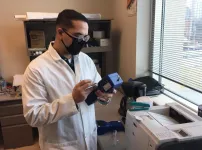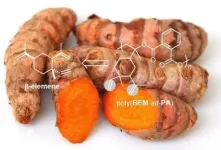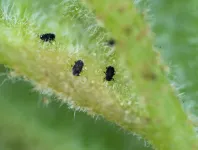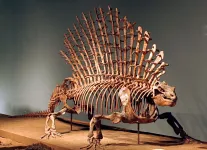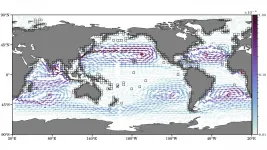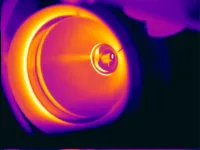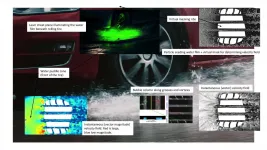Optimizing disinfection to prevent spread of antibiotic resistance in wastewater
Scientists map the degradation of antibiotic resistance gene mecA by common disinfectants to find ways to minimize the spread of resistance in waterbodies
2021-03-02
(Press-News.org) For nearly a century, improvement in human healthcare has depended heavily on the efficiency with which we can treat bacterial diseases. But today, antibiotic resistance--the ability of certain mutant super-bacteria to block out antibiotics--poses a major threat to healthcare, food security, and overall social development worldwide, threatening to upend much of the progress our civilization has achieved.
Scientists are now urgently attempting to tackle this problem from various angles. Professor Yunho Lee at Gwangju Institute of Science and Technology (GIST), Korea, whose contribution is published in the American Chemical Society's Environmental Science and Technology, is looking at it from the point of view of his field of research--wastewater treatment. "Bacteria, including antibiotic-resistant bacteria and their resistance genes, abound in various aquatic environments. These are therefore dangerous breeding grounds for antibiotic resistance, where through a process called horizontal gene transfer, resistant bacteria could transfer the resistance gene to other bacteria, which could then increase the antibiotic resistance levels among the members of the bacterial community, including pathogens. We could reduce this occurrence, however, if we determined which disinfectants and how much of them could safely and efficiently kill the resistant bacteria and gene in our drinking water and wastewater effluents."
As an initial step towards achieving this, Prof. Lee and his team studied the effects of various amounts of chlorine, ozone, and ultraviolet radiation on the degradation of both extracellular and intracellular (contained within bacteria) methicillin (a type of penicillin) resistance gene, mecA, of the bacteria Staphylococcus aureus in water. Based on high resolution observations using scanning electron microscopy and an analysis of the effect of the disinfectants on the reaction dynamics and cell structure, the scientists developed a reaction kinetics model for each disinfectant versus mecA in addition to a method for measuring the degradation rates. Their experiments verified the effectiveness of their models and method.
"Our findings are a key step in determining the optimal conditions for wastewater disinfection process operations for eliminating mecA and mitigating the spread of antibiotic resistance through our municipal wastewater systems," says Prof. Lee. "In this way, our research significantly contributes to public health protection against infection by antibiotic-resistant bacteria."
Moreover, Prof. Lee is hopeful that their models can be applied to other segments of double stranded DNA as well, such as those of certain viruses. Thus, newer approaches like these could hopefully lead to sustainable solutions to the looming antibiotic resistance problem and more in the near future.
INFORMATION:
About Gwangju Institute of Science and Technology (GIST)
Gwangju Institute of Science and Technology (GIST) is a research-oriented university situated in Gwangju, South Korea. One of the most prestigious schools in South Korea, it was founded in 1993. The university aims to create a strong research environment to spur advancements in science and technology and to promote collaboration between foreign and domestic research programs. With its motto, "A Proud Creator of Future Science and Technology," the university has consistently received one of the highest university rankings in Korea.
Website: http://www.gist.ac.kr/
About the Author
Dr. Yunho Lee is a Professor with the School of Earth Sciences and Environmental Engineering at GIST, Korea. Before joining GIST, he completed a PhD in at the Chemical Engineering Department at Seoul National University and a postdoctoral research degree at the Swiss Federal Institute of Aquatic Science and Technology. His research focuses on characterizing and optimizing photochemical and oxidative water treatment processes for drinking waters and municipal and industrial wastewaters for abating organic and biological contaminants of concern with minimized toxic by-product formation. As of today, he has published more than 80 research papers in his field and is an editor of Elsevier's Journal of Environmental and Chemical Engineering.
[Attachments] See images for this press release:
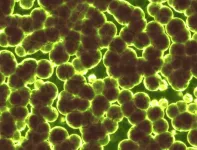
ELSE PRESS RELEASES FROM THIS DATE:
2021-03-02
If you're looking for an indoor space with a low level of particulate air pollution, a commercial airliner flying at cruising altitude may be your best option. A newly reported study of air quality in indoor spaces such as stores, restaurants, offices, public transportation -- and commercial jets -- shows aircraft cabins with the lowest levels of tiny aerosol particles.
Conducted in July 2020, the study included monitoring both the number of particles and their total mass across a broad range of indoor locations, including 19 commercial flights in which measurements took place throughout ...
2021-03-02
Finding innovative and sustainable solutions to our material needs is one of the core objectives of green chemistry. The myriad plastics that envelop our daily life - from mattresses to food and cars - are mostly made from oil-based monomers which are the building blocks of polymers. Therefore, finding bio-based monomers for polymer synthesis is attractive to achieve more sustainable solutions in materials development.
In a paper published in ACS Sustainable Chemistry & Engineering, researchers from the Kleij group present a new route to prepare biobased polyesters with tuneable properties. The researchers ...
2021-03-02
Insects can reprogram plant growth, transforming ordinary plant parts into intricately patterned shelters that are safe havens for feeding and reproduction.
These structures, called galls, have fascinated biologists for centuries. They're crafted by a variety of insects, including some species of aphids, mites, and wasps. And they take on innumerable forms, each specific in shape and size to the insect species that's created it - from knobs to cone-shaped protrusions to long, thin spikes. Some even resemble flowers.
Insects create galls by manipulating the development of plants, but figuring out exactly how they perform this feat "feels like ...
2021-03-02
The backbone is the Swiss Army Knife of mammal locomotion. It can function in all sorts of ways that allows living mammals to have remarkable diversity in their movements. They can run, swim, climb and fly all due, in part, to the extensive reorganization of their vertebral column, which occurred over roughly 320 million years of evolution.
Open any anatomy textbook and you'll find the long-standing hypothesis that the evolution of the mammal backbone, which is uniquely capable of sagittal (up and down) movements, evolved from a backbone that functioned ...
2021-03-02
WASHINGTON, March 2, 2021 -- Tons of plastic debris get released into the ocean every day, and most of it accumulates within the middle of garbage patches, which tend to float on the oceans' surface in the center of each of their regions. The most infamous one, known as the Great Pacific Garbage Patch, is in the North Pacific Ocean.
Researchers in the U.S. and Germany decided to explore which pathways transport debris from the coasts to the middle of the oceans, as well as the relative strengths of different subtropical gyres in the oceans and how they influence long-term accumulation of debris.
In Chaos, from AIP Publishing, Philippe Miron, Francisco Beron-Vera, Luzie Helfmann, and Peter Koltai report creating a Markov chain ...
2021-03-02
What The Study Did: This study investigates emergency department visits for violence-related injuries occurring at home and outside the home in Cardiff, Wales, before and after COVID-19 lockdown measures were instituted in March 2020.
Authors: Jonathan P. Shepherd, Ph.D., Crime and Security Research Institute at Cardiff University in Wales, is the corresponding author.
To access the embargoed study: Visit our For The Media website at this link https://media.jamanetwork.com/
(doi:10.1001/jama.2020.25511)
Editor's Note: Please see the article for additional information, including other authors, author contributions ...
2021-03-02
In a mouse study, Australian researchers have mapped out what happens behind the scenes in fat tissue during intermittent fasting, showing that it triggers a cascade of dramatic changes, depending on the type of fat deposits and where they are located around the body.
Using state-of-the-art instruments, University of Sydney researchers discovered that fat around the stomach, which can accumulate into a 'protruding tummy' in humans, was found to go into 'preservation mode', adapting over time and becoming more resistant to weight loss.
The findings are published today in Cell Reports.
A research team led by Dr Mark Larance examined fat tissue types from different locations to understand their role during every-other-day fasting, ...
2021-03-02
The first UK COVID-19 lockdown saw a "rapid and sustained" fall in violence outside the home in the Welsh capital city, a new study led by Cardiff University has shown.
Researchers from Cardiff University's Crime and Security Research Institute (CSRI) and the US Centers for Disease Control and Prevention studied data from Cardiff's sole emergency department (ED) from March to June 2020 and compared it to weekly data from January 2019 onwards.
They found there were almost 60% fewer attendances per week for violent injury outside the home in the first lockdown during ...
2021-03-02
WASHINGTON, March 2, 2021 -- When a vehicle travels over a wet or flooded road, water builds up in front of the tire and generates a lift force. In a phenomenon known as hydroplaning, this force can become large enough to lift the vehicle off the ground.
In Physics of Fluids, by AIP Publishing, scientists from the CNRS, the University of Lyon, and The Michelin Group use a laser imaging technique to study water flow in front of and through tire grooves.
To counteract hydroplaning, tread designs are chosen to drain water from the front of the tire without decreasing its ability to adhere to the road. Very few quantitative experimental studies of the movement of water through tire grooves have been done, so little is known about the exact flow patterns in ...
2021-03-02
What The Study Did: This study suggests that, during the COVID-19 pandemic, a hotel- based isolation and quarantine strategy that delivers integrated medical and behavioral health support to people experiencing homelessness can be done safely outside the hospital setting.
Authors: Jonathan D. Fuchs, M.D., M.P.H., of the San Francisco Department of Public Health, is the corresponding author.
To access the embargoed study: Visit our For The Media website at this link https://media.jamanetwork.com/
(doi:10.1001/jamanetworkopen.2021.0490)
Editor's Note: The article includes conflict of interest and funding/support disclosures. Please see the article for additional information, including other authors, author contributions and affiliations, conflict of interest ...
LAST 30 PRESS RELEASES:
[Press-News.org] Optimizing disinfection to prevent spread of antibiotic resistance in wastewater
Scientists map the degradation of antibiotic resistance gene mecA by common disinfectants to find ways to minimize the spread of resistance in waterbodies

